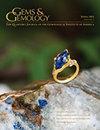白云石相关软玉的氢氧稳定同位素比值及其地质意义
IF 1.6
3区 地球科学
Q2 MINERALOGY
引用次数: 3
摘要
2020年夏季宝石与宝石软玉是一种近单矿物岩石,由透闪石-阳起石、Ca2(Mg,Fe)5Si8O22(OH)2组成。它分布在世界各地(图1),根据母岩和含矿岩的不同,分为白云石相关或蛇纹岩相关,这两种类型都是由交代作用形成的(Yui et al.,1988;Tang et al.,1994;Yang和Abduriyim,1994;Harlow和Sorensen,2005;Burtseva et al.,2015)。大型和著名的白云石相关软玉矿床分布在中国新疆维吾尔自治区(以下简称新疆)、中国青海省、俄罗斯西伯利亚和韩国春川(图1)。本研究还使用了意大利Val Malenco和波兰Złoty Stok等小型矿床的数据(图1)。其余数据来自中国多个小规模来源的软玉:岫岩、唐河、大华和罗店(图2)。对于软玉,由于其文化意义因位置不同而不同,因此重视地理来源。有意见是可能的本文章由计算机程序翻译,如有差异,请以英文原文为准。
Hydrogen and Oxygen Stable Isotope Ratios of Dolomite-Related Nephrite: Relevance for its Geographic Origin and Geological Significance
GEMS & GEMOLOGY SUMMER 2020 Nephrite is a near-monomineralic rock composed of tremolite-actinolite, Ca2(Mg,Fe)5Si8O22(OH)2. It occurs worldwide (figure 1) and is classified as dolomite-related or serpentine-related according to the different parent rocks and ore-hosting rocks, and both types form by metasomatism (Yui et al., 1988; Tang et al., 1994; Yang and Abduriyim, 1994; Harlow and Sorensen, 2005; Burtseva et al., 2015). The large and well-known dolomite-related nephrite deposits are distributed in the Xinjiang Uyghur Autonomous Region (hereafter abbreviated as Xinjiang) of China, Qinghai Province of China, Siberia in Russia, and Chuncheon in South Korea (figure 1). Data from smaller-scale deposits such as Val Malenco in Italy and Złoty Stok in Poland are also used in this study (figure 1). The rest of the data were collected from nephrites produced at multiple small-scale sources in China: Xiuyan, Tanghe, Dahua, and Luodian (figure 2). With nephrite jade, a premium is placed on geographic origin since the gem’s cultural significance differs by location. It is possible to have an opinion
求助全文
通过发布文献求助,成功后即可免费获取论文全文。
去求助
来源期刊

Gems & Gemology
地学-矿物学
CiteScore
2.90
自引率
19.20%
发文量
10
期刊介绍:
G&G publishes original articles on gem materials and research in gemology and related fields. Manuscript topics include, but are not limited to:
Laboratory or field research;
Comprehensive reviews of important topics in the field;
Synthetics, imitations, and treatments;
Trade issues;
Recent discoveries or developments in gemology and related fields (e.g., new instruments or identification techniques, gem minerals for the collector, and lapidary techniques);
Descriptions of notable gem materials and localities;
Jewelry manufacturing arts, historical jewelry, and museum exhibits.
 求助内容:
求助内容: 应助结果提醒方式:
应助结果提醒方式:


